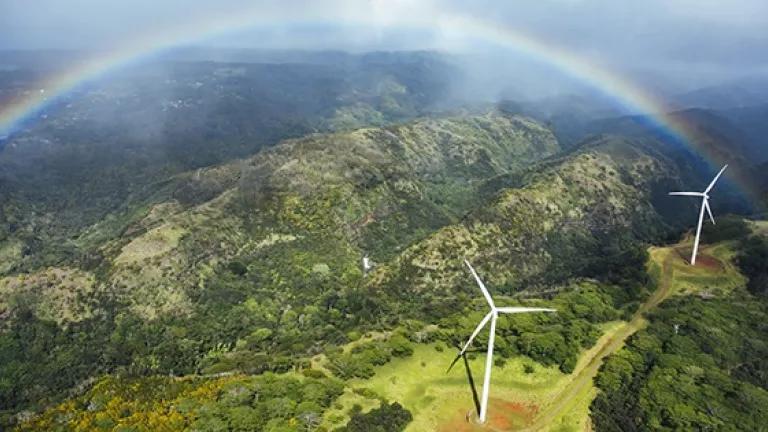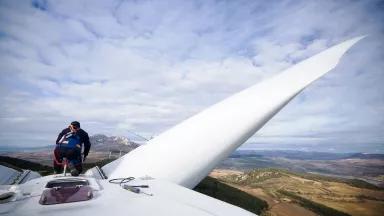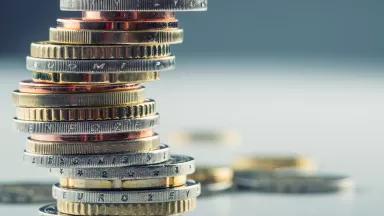How Green Banks Are Financing the Fight Against Climate Change
Investing is risky business, but these institutions know that failing to fund clean energy is even riskier.

National Renewable Energy Laboratory staff attaching the DLR rotor and blades to a research turbine at NREL's National Wind Technology Center in Boulder, Colorado
Lee Jay Fingersh/NREL, 54227
Imagine you've got a brilliant idea for some promising new business in the clean energy sector—maybe one that connects farmers with agrivoltaics developers, or one that helps property owners cut through all the red tape that’s involved with installing rooftop solar. You’ve written up a solid business plan. You’ve already lined up potential clients and suppliers. You just need some capital investment to help get the whole thing up and running. How do you go about finding it?
You might start by looking into green banks.
What are green banks, and how do they differ from regular banks?
Green banks are financial institutions that are specifically designed to help speed up the transition to a clean energy, net-zero-emissions future. By using public money to leverage private capital, they help finance a wide variety of projects that aim to lower carbon emissions, create jobs, and strengthen local communities. Unlike conventional banks, green banks are generally established with public dollars; as a result, most are either public or quasi-public. And while green banks are mission-driven, they’re not philanthropic institutions. They don’t give money away. Instead, they seek to be bridges between private capital and the demonstrable public interest in clean energy and sustainable development.

Kelly Bridge Community Solar Farm in Liberty, New York, which received support from NY Green Bank’s community solar program
Delaware River Solar/Nimble Dragon Studios
How do green banks work?
All investments come with risk. Potential investors in enviro-forward projects might be apprehensive about supporting novel green technologies or new businesses that haven’t yet built a track record of success. To protect their money, potential investors may ask for prohibitively high rates of return, or even decide against investing altogether.
One of the most important roles of a green bank is to mitigate these perceived risks. Using a variety of financial tools at their disposal—such as loan loss reserve funds, loan guarantees, and other forms of credit enhancement—green banks work to make private lenders feel more secure with environmentally responsible investments. Or, to put it more accurately, green banks nudge hesitant investors into action by assuming a portion of this risk themselves. Essentially, they tell investors: “Look, we have faith in this particular clean energy project, and we firmly believe that you’ll end up receiving a good return on any investment that you make in it. But if you’re still on the fence, we’ll use our own money, if we have to, in order to make sure that you don’t lose yours.”
Another way that green banks facilitate investments is through securitization. By pooling loans into portfolios, green banks can create financial instruments that allow investors to spread their money across a wide range of projects simultaneously and at a reduced risk. Some green banks may also invest directly in certain businesses or projects, under certain circumstances. In New York, for example, one local green bank helped a community solar project get off the ground by making a series of early, low-interest loans that the project’s developers could repay easily and on schedule—thereby establishing creditworthiness and making the project more attractive to other, more conventional investors.
Where are green banks boosting sustainable finance the most?
More than two dozen green banks already exist in 12 countries at either the national or regional level—and dozens more are in the works, many of them in developing nations. Some of these existing banks have played a major role in helping their countries grow out their clean energy sectors and meet their national climate targets. For example: Australia’s trailblazing national green bank, the Clean Energy Finance Corporation, has already facilitated more than $37 billion in investments over 10 years. That money has gone on to finance thousands of projects ranging from renewable energy generation to sustainable red meat production. Other nations that have embraced a green banking model include Brazil, India, Japan, and Malaysia. While China can’t yet boast a national green bank per se, it is currently exploring ways of integrating green banking methods into the operations of its state-owned financial institutions.
Members of the Green Bank Network, an international coalition of green banks managed by NRDC and dedicated to sharing information and best practices, have leveraged roughly $50 billion of their own funds to attract another $86 billion in private capital, for a total of $136 billion in investments through mid-2022. More than 63 percent of the total has been invested in clean energy projects; about 12 percent has gone toward projects designed to maximize energy efficiency. (The remaining quarter has been divided among other areas of interest, including low-emissions vehicles, waste and water management, and energy storage.)

President Joe Biden signing the Inflation Reduction Act, August 16, 2022
Cameron Smith/White House
Does the United States have a green bank?
Yes and no. The United States is currently host to a number of successful state and local green banks, which have collectively parlayed roughly $2.5 billion of public and philanthropic funding into $9 billion of investment in green projects across the country. But there is no national U.S. green bank operating at the same level as those in Australia, Japan, and elsewhere. The result? Many areas of the country have been overlooked in the clean energy transition.
That could soon change. The Inflation Reduction Act, signed into law by President Biden last August, has created a $27 billion federal climate fund to help finance projects that promote clean energy, reduce carbon emissions, and protect communities. The first-of-its-kind Greenhouse Gas Reduction Fund, administered by the U.S. Environmental Protection Agency, will provide catalytic financial support to states, municipalities, tribal governments, and mission-driven organizations—including existing green banks and community-based lenders, such as community development financial institutions and credit unions. In doing so, the fund will help these institutions more rapidly deploy investments in renewable energy, energy efficiency retrofits, and clean transportation. Notably, $15 billion is explicitly set aside for investment in low-income and disadvantaged communities, making the fund a significant accelerator of climate justice in the United States as well. Together with other provisions in the new law, the fund represents the largest attempt yet to finance American climate action.
We need climate action to be a top priority in Washington!
Tell President Biden and Congress to slash climate pollution and reduce our dependence on fossil fuels.

Urge President Biden and Congress to make equitable climate action a top priority
2023 was the hottest year on record, underscoring the urgency of shifting to clean energy and curbing the carbon pollution that is driving the climate crisis. President Biden and Congress have the tools to get the job done.
This NRDC.org story is available for online republication by news media outlets or nonprofits under these conditions: The writer(s) must be credited with a byline; you must note prominently that the story was originally published by NRDC.org and link to the original; the story cannot be edited (beyond simple things such as grammar); you can’t resell the story in any form or grant republishing rights to other outlets; you can’t republish our material wholesale or automatically—you need to select stories individually; you can’t republish the photos or graphics on our site without specific permission; you should drop us a note to let us know when you’ve used one of our stories.



Will COP26 Move Us Closer to Solving the Climate Crisis?
The Global Plastics Treaty: It’s Time to Clean Up Our Mess
1.5 Degrees of Global Warming—Are We There Yet?